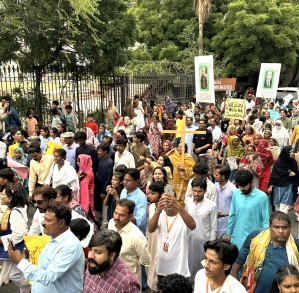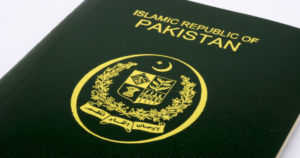
Learning from a long history of global inaction, regimes are pursuing a new form of genocide, as seen in campaigns against the Rohingya, the Uyghurs, and others.
Responding to humanity’s greatest crime is getting harder, and we may not be prepared to rise to the occasion. Genocides – which drive an irreplaceable loss in the very fabric of human diversity and identity – are not a new phenomenon, nor are they rare for that matter. We live in a world where concurrent developing or ongoing genocides have become almost commonplace. Despite this, we have yet to find effective methods to curb the proliferation of these atrocities and often refrain from taking or even preclude meaningful measures to address them.
But the international community’s hesitance to act is having additional consequences: Genocide has been evolving, and the same dynamics that have limited international response may now be dictating the future of mass atrocity. We have shown the clear limits of our capacity and will to protect the vulnerable, and those seeking to inflict harm have learned. Now, even the will to help may not be enough.
We are seeing patterns of genocidal violence transform in the 21st century, progressively moving away from the approaches of absolute destruction we often associate with the term. This is not to say genocides are becoming less destructive; rather, the way they undertake that destruction is changing along three main lines: duration, intensity, and methodology. These adaptations are a direct reflection of both the attempts made to prevent, mitigate, and prosecute mass atrocity over the last decades and their limitations. The international community has set the rules – and genocidal campaigns are evolving to circumvent them.
The Traditional Prescriptions of Genocide
Diplomat Brief Weekly Newsletter N Get briefed on the story of the week, and developing stories to watch across the Asia-Pacific. Get the Newsletter
Genocide is undoubtedly a long-standing phenomenon, embedded in the most violent parts of our history, but it was the 20th century – bringing with it daunting catastrophes like the Holocaust and the Rwanda genocide – which inevitably shaped our understanding of the term. These campaigns were intense, deadly, and undertaken in a relatively short span of time – with Rwanda seeing over 800,000 dead in only 100 days.
Enjoying this article? Click here to subscribe for full access. Just $5 a month.
During this time, Asia suffered its own manifestations of these maximalist genocidal campaigns in Nanjing, Indonesia, Bangladesh, and Cambodia. In China, the Rape of Nanjing gained infamy after the then-capital’s occupation by Japanese soldiers during the Second Sino-Japanese War, with rampant sexual abuse and a death count that, while heavily contested, is most commonly set at around 200,000. Bangladesh saw the Pakistani armed forces kill between 1 and 3 million people, rape 200,000 women and girls, and displace 40 million in under a year. Similarly, Indonesia lived its own campaign of violence after General Suharto’s military coup in 1965, which led to the army massacre of the nation’s Communist opposition party, with over 400,000 killed in a few months. Finally, in Cambodia, the Khmer Rouge drove 1.7 million people – or about 21 percent of the country’s population – to death in only four years, by way of executions, torture, forced labor, and the denial of basic needs like medication and sufficient food.
These events decimated and profoundly traumatized the generations that suffered them in distinct ways. However, despite their differences, they seemed to follow a similar structure: they were intense, relatively short, and favored deadly means. While these campaigns did not solely rely on mass murder – far from it – they were designed to impose a severe and rapid transformation on the communities they targeted.
But were these genocides to happen today, the backlash and cost the perpetrators would suffer would be much more pronounced. While impunity might have still prevailed – as it often seems to be the case – the visibility, condemnation, and even means of response to the atrocities would have increased significantly, be it due to the visibility of the crimes or the scale of deaths. From sanctions to U.N. peacekeeping missions, the instruments to respond to campaigns of mass death have expanded, if not always yielded the desired results.
In response, genocidal campaigns are adapting to survive and challenge these means of pressure. Political and military leaders are modifying their strategies to limit both the attention paid to their abuses and the ability of the international community to substantially respond to them. With this aim, genocides are progressively becoming longer, varying in intensity, and changing the primary means by which they bring about destruction.
Evolving Dynamics of Genocidal Campaigns
Modern genocidal campaigns seem to be lasting longer – and not just slightly longer. They seem to be extending into the decades. Darfur has remained mired in conflict for over 20 years. The Rohingya genocide had its start much earlier than has been recognized, with the 1982 Myanmar Citizenship Law setting the scene for the group to become a stateless people, and later be driven out of the country. Similar violence has plagued the Democratic Republic of the Congo since the 1990s, and Ethiopia is set to follow the same slow descent.
This is, of course, not a universal prescription. The Yazidi genocide saw its formal end with the collapse of Islamic State’s dominance in parts of Iraq and Syria in just a few years. It’s also not an entirely modern phenomenon. Indigenous populations around the world have experienced prolonged genocidal violence for hundreds of years. But this shift seems to be rooted in the fact that extended campaigns of violence are becoming the new norm.
By expanding the duration of genocides, governments are gaining leeway with regards to the tactics they can deploy against the communities they want to target. They can also strategically reduce the intensity of their offensives when needed to avoid or minimize foreign backlash. Indeed, these long-term strategies are successfully sustained by increasingly transitioning to relatively low-intensity campaigns of protracted violence – that is, spread out attacks that do not tend to generate single large-scale massacres like those of the 20th century. Instead, modern campaigns are progressively opting for more sporadic offensives with limited casualties, scorched-earth campaigns, and the use of structural means to slowly divest people of their basic rights and protections. This is sometimes called “genocide by attrition.”
Lesser-intensity periods of these conflicts can sometimes be misinterpreted as progress toward a resolution, rather than as a means to reduce unwanted attention. As such, these genocides dangle the possibility of peace, with no intention of following through, to encourage the diversion of international and humanitarian attention to more acute crises.
As a result, new genocidal campaigns seem to be employing what is called a slow violence approach – a form of structural and progressive aggression experienced over many years or even generations that, in this case, seeks to normalize and institutionalize the progressive destruction of a community. This form of violence favors inattention from external actors, especially in a climate of rapidly emerging humanitarian crises.
Enjoying this article? Click here to subscribe for full access. Just $5 a month.
Indeed, our current policy responses are not prepared to respond to long-term low-intensity violence. Most operate on the basis of concentrated responses to short-term peaks and struggle to maintain sustained action. As the situation in a given country begins to appear intractable, public pressure and international interest lessen, allowing states to continue their genocidal campaigns with little opposition or accountability. As it stands, not only will future genocides likely follow this pattern – they seem to already be doing so.
The case of the Rohingya stands as the most prominent ongoing genocide in Asia. After decades of structural abuse, repression, and even the denial of their citizenship by Myanmar’s government and military, the Rohingya are now one of the largest stateless populations in the world. With over 900,000 displaced in refugee camps in Bangladesh and another 600,000 remaining subject to violence in Myanmar’s Rakhine State, the Rohingya have suffered progressive disenfranchisement that has left them with little prospects to survive.
What makes this case key is the way it precisely reflects the changing nature of genocidal violence – it has been a decades-long progressive campaign, with varying phases of intensity, to the point that Nicholas Kristof’s 2018 New York Times piece defined it as “slow-motion genocide.” His reporting evidences that Myanmar kills more Rohingya through starvation and denial of basic care than through more direct forms of violence, like executions or beatings. In this way, the state facilitates deniability and sets the stage for the community to perish without resorting to mass killings. This is precisely the last great appreciable shift we are seeing in current genocides – a deviation from mass death to mass trauma as the prime driver used to destroy targeted communities.
The method in which genocides are being carried out is changing. Perpetrators are shifting their focus to similarly damaging but less directly fatal tactics – including forced mass displacement, resource starvation, sexual violence, the denial of basic services, and forced absorption. These “alternative” forms of violence may not necessarily result in immediate death, but progressively impede and erode the continuity of the community until its dissolution or disappearance.
While a variety of means have been long used in carrying out genocidal projects – such as mass starvation, as was the case of the Holodomor, where a Russian-imposed famine killed millions of Ukrainians in two years from 1932-33 – we still tend to downplay the significance and impact of non-fatal abuses on affected communities. In this way, we uphold an artificial hierarchy of violence that implicitly marginalizes the experience of groups most often subject to other forms of violence, like women, the disabled, or the elderly. As in previous shifts, it’s not so much that the tactics themselves are novel, but their increasing prominence and centrality in genocidal strategies calls for attention.
A relevant example of the use of mass trauma and forced absorption as a means of genocide is the situation of the Uyghurs in China. Over 1 million members of the community have been forcibly displaced into “re-education camps” – the largest mass internment of an ethnoreligious minority since World War II – with the pretext of favoring integration and offering “education and vocational training.” While in detention, Uyghurs and other Turkic minority groups have been subjected to forced labor, involuntary sterilization, sexual violence, and torture, as well as denied their basic cultural and religious practices. Already widely recognized as a genocide, this campaign relies primarily on the imposition of mass trauma and non-fatal violence as a way to slowly crumble the foundations of the Uyghur community and identity.
With a minimal international response, it seems like the methodology used by the Chinese government has created only enough discontent to warrant verbal condemnation and some sanctions against Chinese officials, but little else – far from a costly or notable price to pay. As such, it sets a precedent of our inability to mobilize when confronted with mass abuse, but not necessarily mass death.
Genocide Is Adapting, But Are We Ready to Respond?
These developments are an ominous sign of what is to come. As perpetrators shift away from practices that would call more directly upon international intervention, we can expect to see ongoing and future genocides transform into slow-violence and low-intensity campaigns of mass trauma, increasingly perpetrated by indirectly fatal means. As it stands, we are willfully unprepared to confront or exert continued pressure to address these new patterns of genocidal violence.
Indeed, our track record in responding to even the most staggering cases of genocide is abysmal. However, we can seek to enact policy changes to prepare for the changes we can already see gaining traction, rather than shield ourselves with the same excuses of misinformation and political self-interest we have seen before. If we are to uphold our promises to prevent and punish genocide, we will need to reconceptualize our understanding of genocidal escalation and create a more expansive policy architecture that is ready to leverage a wider scope of political pressure points, economic sanctions, international justice mechanisms, and social movements to generate enduring responses to these new iterations of mass social trauma.
Failing that, we may be at the advent of another century of genocide.




